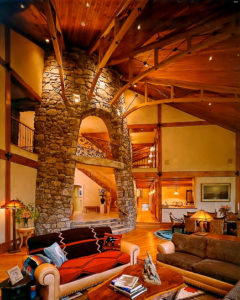How does an architect find inspiration?
The perpetual inspiration that most architects have is one of problem-solving through the use of space. For instance, when I was a kid my fascination was not for going for a ride in a car, but for the car’s design and the experience of being encapsulated by it. When I climbed a tree it was compelling, not because of the view. but because in the tree I could experience first-hand its structural system and protective canopy. When I was a child, my dad created a sandbox large enough to create small civilizations. I learned to see the world as a special environment that can be organized to meet the needs of the civilization. I didn’t just build a castle, I built cities and towns. Many of Hudson Design’s interns have had similar experiences when playing with blocks as a kid. At a young age, they learned how to use materials to plan out spaces.

What is an architect’s creative process?
An architect’s creative process is distinctly and necessarily more disciplined than other design practices because the structures require more planning to withstand the test of time. For instance, to make the design stable it must be environmentally sound, meaning all environmental impacts have been taken into account to produce an optimal structure. Before the design process can begin, we must first understand the rules, building codes, homeowners associations, preservation council, etc. Additionally, we need to understand the values of the neighborhood, the community at large, and the client in person. Each client has their own cultural baggage regarding buildings and their spaces. An Architect first assimilates general and broad ideas and gradually works their way into more specificity, taking in ever increasingly finite data and articulating that data into architectural reality.
What makes a design innovative?
Innovation is, most often, the product of collaboration and cooperation. Architects conduct an orchestra of engineers, builders, suppliers, tradespeople, and craftsmen to create a composition to serve the Client. No two Clients are alike and innovation keeps our solutions fresh. Our goal is to help others express their lifestyle beautifully and create value over time. We innovate to solve their problems with new ideas by brainstorming possible solutions. When everyone involved in the design and implementation process brings their compassion and humility to the table, we can explore a variety of innovations to accomplish more as a team.
What style of architecture do you love or appreciate the most?
My favorite architectural styles are those that respond most closely to their particular cultural and dynamic context. Designs such as the adobe dwellings in the Southwestern United States and the chalet structures in the Alpine regions of Western Europe, each respond to particular natural, cultural, and social influences. To effectively serve others, Architects don’t have the luxury of a favorite design style. Styles express a number of influences that are appropriate for their time and each is unique in its own way. There can be no end to the variety of architectural styles.
What advice would you give aspiring architects?
Travel is a great inspirer. But don’t just travel to see great buildings, travel to see great landscapes, natural settings as well as human endeavors. Some of the best inspirations in architecture come from nature. Lake Orta in northern Italy, for example, has the charm of a place that time has forgotten. Often in nature, there are seemingly random, yet ordered visual cues that can inform our designs. Great architecture is quiet and intimate, as well as grand scale. And don’t forget to travel with a sketchbook and camera.
To learn more about James Masson Copeland and Hudson Design architectural services, please visit hudsondesign.pro to get in touch.













